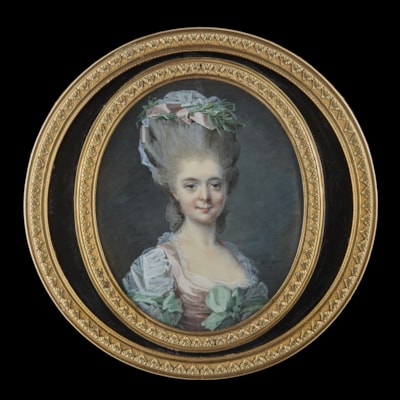GERVASE SPENCER
(c.1715-1763)A Lady, wearing ‘Turkish-style’ dress; 1748
Enamel on copper
Signed and dated on the counter-enamel ‘G. Spencer. pinx./1748’
Oval, 44mm (1.7in) high
Gilt metal mount with stamped detail
£5,000
Britain had a long history with the Ottoman Empire, being one of the first countries to establish an embassy in Istanbul in 1535. In the 1740s, the war of Austrian Succession meant that British troops were fighting closer to the Ottoman-controlled Mediterranean[2]. Though this did not spell good news for British-Ottoman relations, it did mean that more and more British men were gaining exposure to the cultures, and more importantly in this case fashions, of the empire. The robe that the lady in this miniature wears is known in Turkish as a Kurdi, and typically takes the form of a floor-length robe trimmed with fur. Such robes became popular amongst western women, as did hair turbans, also seen in this portrait.
Whereas later works were often signed on the obverse, this miniature has been signed and dated on the counter-enamel. Therefore, it is a rarer and earlier example of Spencer’s work. He became known for his fashionable portraits, and this is certainly not an exception. Though the colours of the woman’s outfit are more subdued than in other examples, such as the V & A portrait, she has still been depicted as a glamorous and wealthy sitter.
[1] Victoria and Albert Museum, London, accession number P.4-1943.
[2] M. Talbot, British-Ottoman Relations, 1713-1779: Commerce, Diplomacy, and Violence, Gale Internation, online at https://www.gale.com/intl/essays/michael-talbot-british-ottoman-relations-1713-
1779-commerce-diplomacy-violence.
Bonham’s, London, Fine Portrait Miniatures, 23 November 2005, lot 32;
Private Collection, UK.

shipping notice
Worldwide shipping is included in all prices.
The Limner Company does not accept any responsibility for import duty, this is to be paid by the buyer.
Some stock items contain materials from endangered species which are governed by CITES regulations and will require a permit to export outside of Great Britain. If a certificate of export is required then this will be the responsibility of and paid for by the buyer .
you may also like



 +44(0)7983510056
+44(0)7983510056











